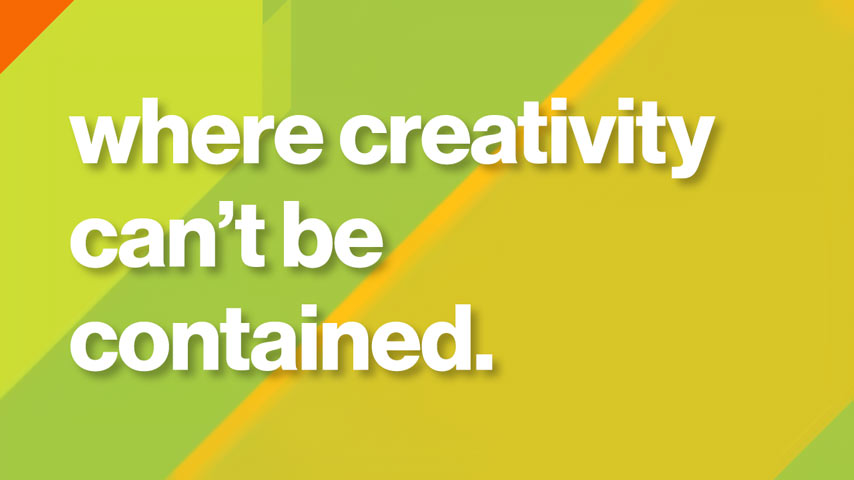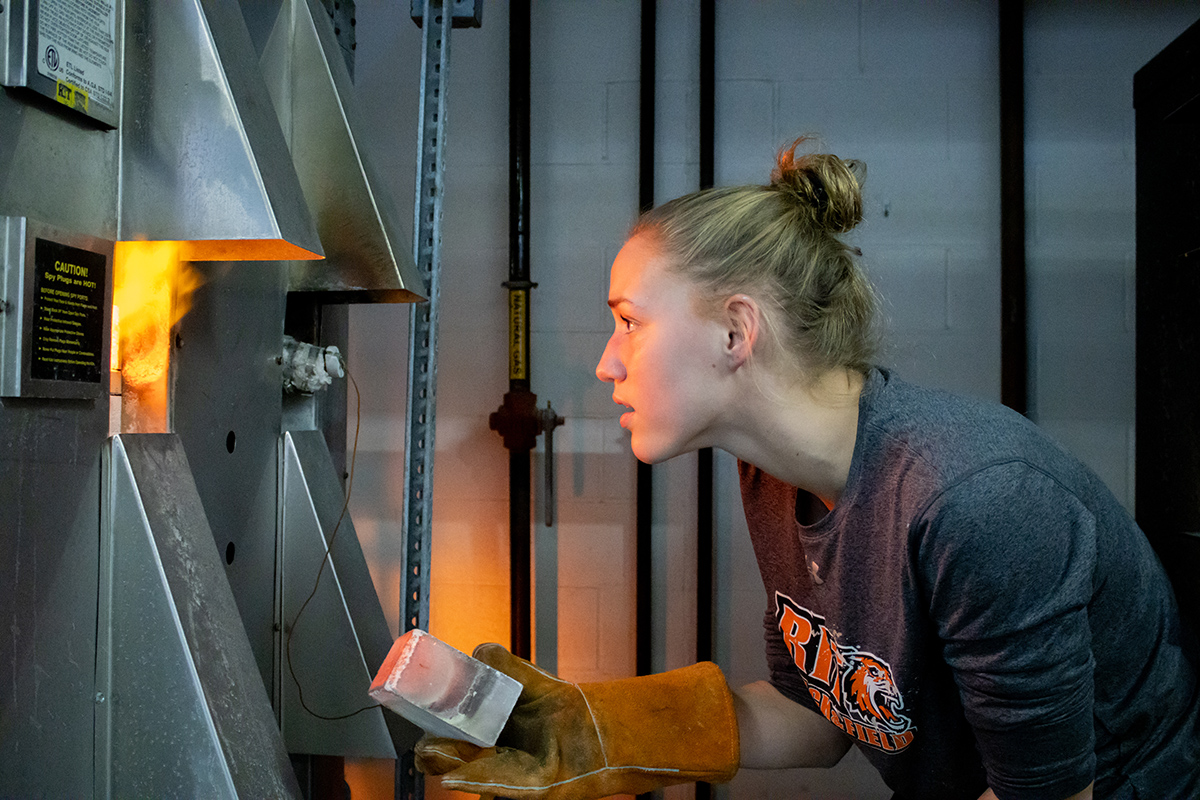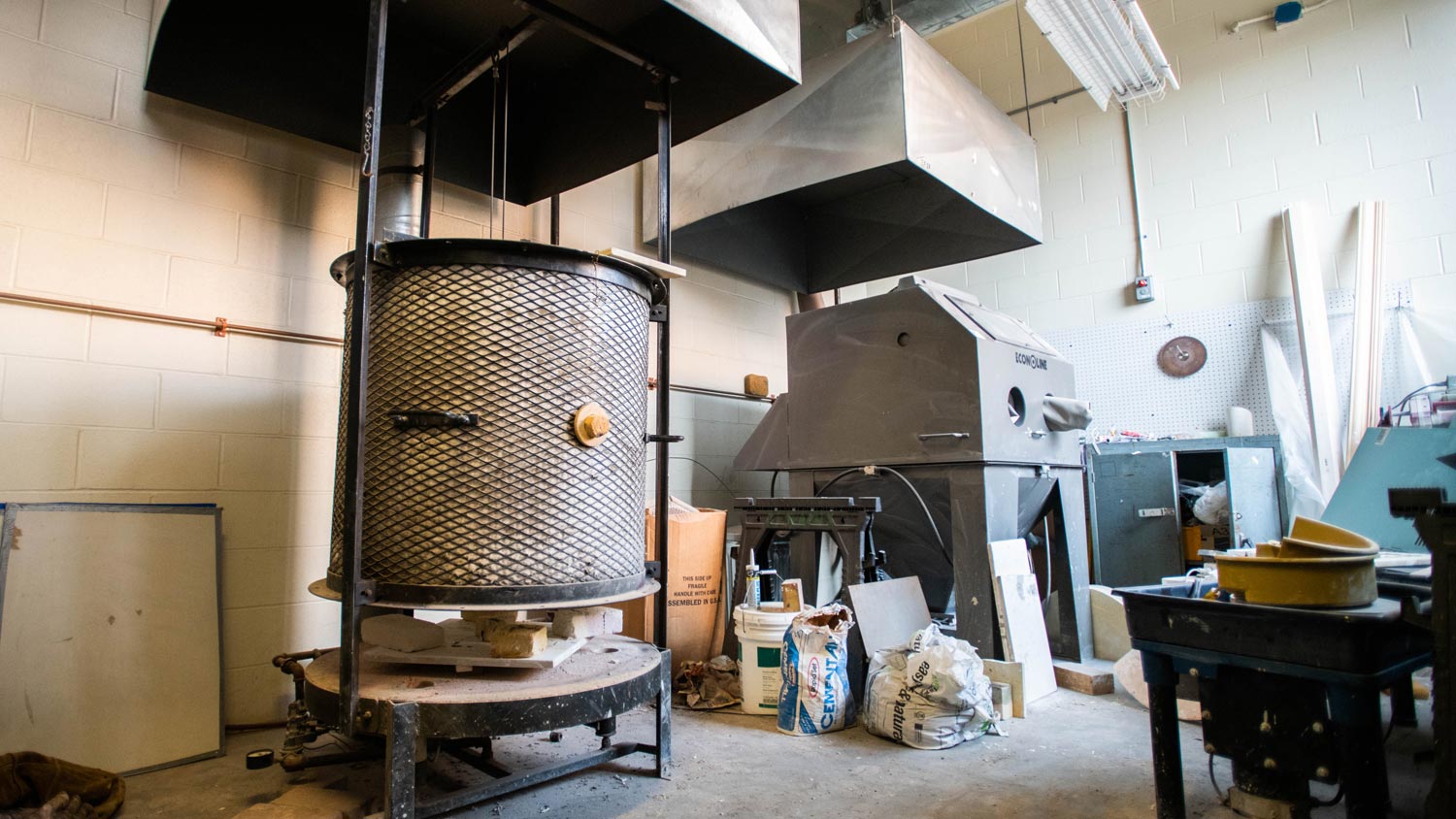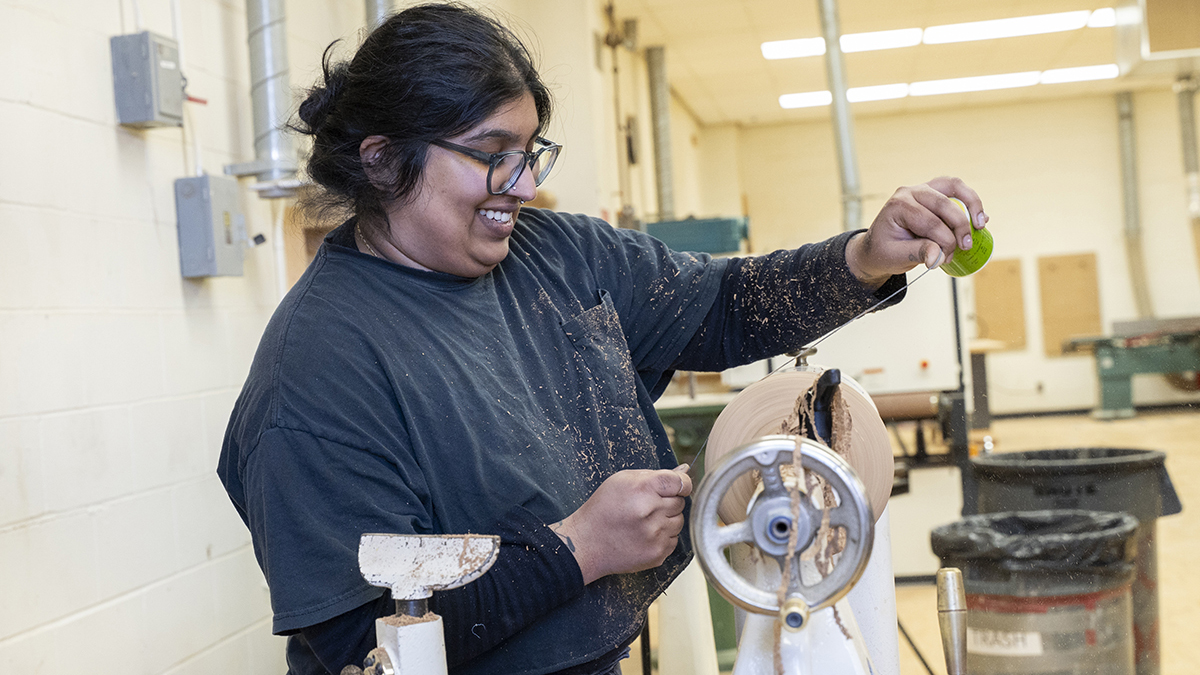Studio Arts Bachelor of Fine Arts Degree
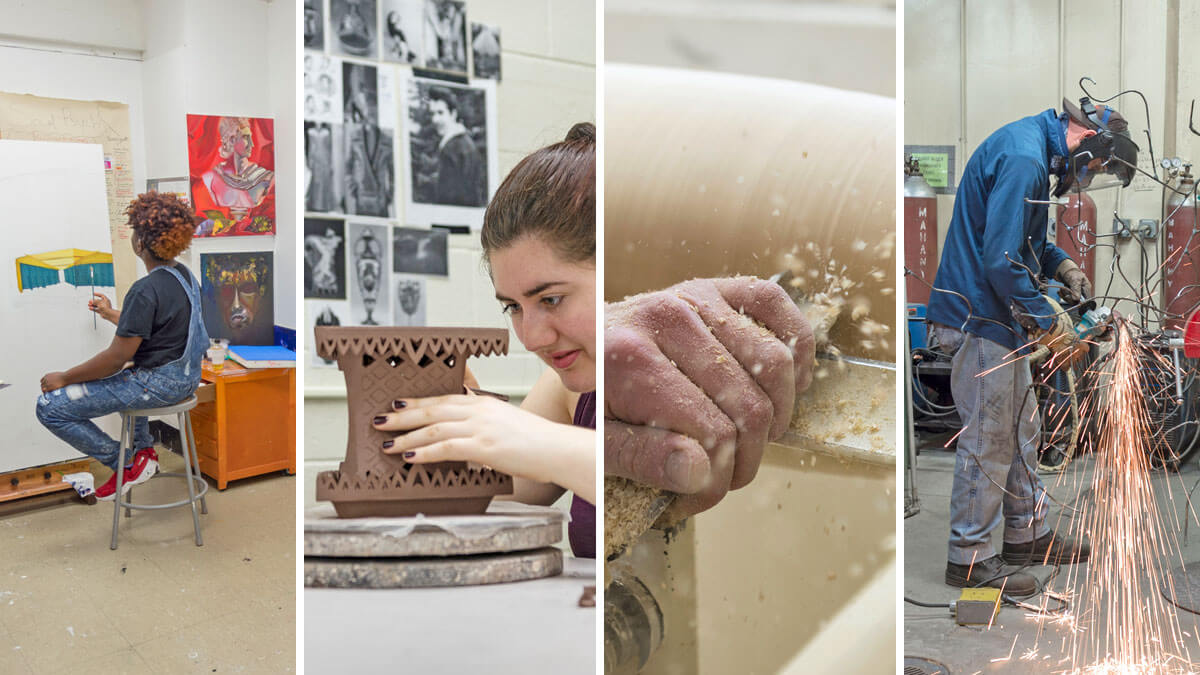
Studio Arts
Bachelor of Fine Arts Degree
- RIT /
- College of Art and Design /
- Academics /
- Studio Arts BFA
Overview for Studio Arts BFA
Why Study Studio Arts at RIT
Focused Degree Options: Your choice of studio arts options including ceramics, furniture design, glass, metals and jewelry design, painting, printmaking, and sculpture and expanded forms.
Exhibit your Work: During senior year, your final body of work will be featured in a gallery.
College Preparation Workshops: High school juniors and seniors can participate in the two-week School of Art's annual Pre-College Portfolio Preparation Workshop.
A studio art major focuses on the development of artistic skills and the creation of visual or fine art so you can pursue a career as a professional artist and more depending on your individual career goals and specialization. RIT’s fine and studio art major offers options in ceramics, furniture design, glass, metals and jewelry design, painting, printmaking, and sculpture and expanded forms.
RIT’s Bachelor in Studio Arts
Acquire the conceptual and technical skills required to succeed as creative professional in a community that is fostered through shared experiences and facilitated programs.
- Engage in comprehensive inquiry that expands and supports your subject matter knowledge, ideation through sketches and models, articulation of a rationale for the application of media and process, and finally the refinement of your work through editing and critique.
- Explore a wide scope of visual arts and study their cultural relevance through visiting artists, trips to museums, and attendance at professional conferences.
- Exhibit you final body of work in a gallery during your senior year
- Receive guidance and partake in experiential projects focusing on the presentation of work, self-promotion, business practice, and issues of professional engagement within the field help you thrive as creative professionals after graduation.
- Learn from inspiring artists in the field. Faculty members are active artists who exhibit widely and are committed to diverse approaches to art-making. They offer support and networking opportunities as students emerge as professionals.
Studio Arts Options
A studio arts major with a variety of options available.
The studio arts major offers a variety of options for you to delve further into your studio art topic of interest. You may choose an option in one of the following areas:
- Ceramics–The ceramics option supports a range of fundamental topics within ceramics and the development of professional and practical skills necessary to operate a studio business.
- Furniture design–The furniture design option engages students in the pursuit of their creative interests while providing a comprehensive technical background in contemporary woodworking.
- Glass–The glass option cultivates each student’s creative potential with glass through studio instruction in glassblowing, flame-working, glass imaging processes, and more.
- Metals and jewelry design–The metals and jewelry design option focuses on design, aesthetics, as well as material and process mastery.
- Painting–Students selecting the painting option engage in contemporary visual art practice through a personal exploration of painting techniques.
- Printmaking–The printmaking option addresses a wide variety of media, tools, and both traditional and technological techniques, as well as theoretical concepts to facilitate skill development and experimentation processes.
- Sculpture and Expanded Forms– The sculpture and expanded forms option cultivates the use of three-dimensional space and four-dimensional time through various materials and techniques from traditional bronze casting and stone carving to digital printing and installations.
What can you do with a studio art degree?
The specific career path can you choose can vary depending on an your specialization and career goals. Upon completion of the studio art BFA, you may choose to continue you education at the graduate level or begin your career by setting up independent studios and exhibiting your work.
Like our recent graduates, you may also find employment in:
- The fields of art therapy
- Art criticism
- Art restoration/ Archival
- Gallery and museum management
- Set and display design
- Marketing and advertising
- Education
- Auction houses
- Art foundries
- Metal fabrication shops
- Artist residencies
- Non-profit art institutions
- Other creative industries
Gain Real-World Experience with Hands-On Opportunities
Pre-College Portfolio Preparation Workshop
The School of Art's annual Pre-College Portfolio Preparation Workshop is a two-week visual arts class designed to prepare the portfolios of rising high school juniors and seniors for admission to college art programs.
Students also have the opportunity to gain invaluable hands-on experience through participation in paid cooperative education and internships offered through streamlined art and design co-ops.
Enhance Your Studio Art Major and Further your Education
Combined Accelerated Bachelor's/Master's Degree
Today’s careers require advanced degrees grounded in real-world experience. RIT’s Combined Accelerated Bachelor’s/Master’s Degrees enable you to earn both a bachelor’s and a master’s degree in as little as five years of study, all while gaining the valuable hands-on experience that comes from co-ops, internships, research, study abroad, and more.
+1 MBA: Students who enroll in a qualifying undergraduate degree have the opportunity to add an MBA to their bachelor’s degree after their first year of study, depending on their program. Learn how the +1 MBA can. accelerate your learning and position you for success.
-
Apply for Fall 2026
First-year students can apply for Early Decision II by Jan. 1 to get an admissions and financial aid assessment by mid-January.
-
Join Us for Accepted Student Open House
Visit campus on March 28 or April 11 to meet faculty, tour campus, and ask your questions.
Careers and Experiential Learning
Typical Job Titles
| Advertising Director | Appraiser | Art Auctioneer |
| Art Buyer | Art Director | Art Exhibit Coordinator |
| Art Teacher | Artistic Director | Book/Magazine Illustrator |
| Caricaturist | Courtroom Artist | Craft Artist |
| Creative Director | Custom Printer | Designer |
| Exhibit Coordinator | Exhibit Designer | Exhibition Curator |
| Fine Artist | Furniture Designer | Gaffer |
| Gallery Director | Gallery Owner/Curator | Gallery Preparator |
| Glass Artist | Glass Education | Greeting Card Artist |
| Independent Artist | Jeweler | Mural Artist |
| Museum Curator | Painter | Photographer |
| Print Maker | Professional Artist Assistant | Public Demonstration Artist |
| Sculptor | Silkscreen Artist | Small Business Owner/Operator |
| Studio Artist | Studio Technician |
Industries
-
Performing and Fine Arts
-
Retail Stores
-
Advertising, PR, and Marketing
-
Museum
Cooperative Education and Internships
What’s different about an RIT education? It’s the career experience you gain by completing cooperative education and internships with top companies in every single industry. You’ll earn more than a degree. You’ll gain real-world career experience that sets you apart. It’s exposure–early and often–to a variety of professional work environments, career paths, and industries.
Cooperative education, internships, and other experiential learning opportunities are optional but strongly encouraged for students in the BFA in studio arts.
Creative Industry Days
Connect with Design Industry Leaders
RIT’s Office of Career Services and Cooperative Education hosts Creative Industry Days, which connects students majoring in art, design, film and animation, photography, and select computing majors with companies, organizations, creative agencies, design firms, and more. Creative Industry Days are a series of events that allow you to network with company representatives and interview directly for open co-op and full-time employment positions.
Featured Work and Profiles
-
Building a Pipe Organ
A skilled designer and musician, Kelly Cleveland '21 (Furniture Design) constructed an awe-inspiring handmade pipe organ for his capstone project.
Read More about Building a Pipe Organ -
Public Sculpture
Juan Carlos Caballero-Perez, professor of Metals and Jewelry Design, created a near-12-foot sculpture for the Village of Fairport, N.Y.’s Kennelly Park, outside the public library. It was the...
Read More about Public Sculpture -
Furniture Design — With Cork!
RIT's furniture design program welcomed visiting artist Daniel Michalik to explore the wonders of working with cork and its properties as a renewable resource.
Read More about Furniture Design — With Cork! -
Visiting Artist: Corey Pemberton
Corey Pemberton spent three days embedded in the RIT College of Art and Design's creative community in February 2025, leading an artist talk, studio visits with MFA candidates, glassblowing demos, and...
Read More about Visiting Artist: Corey Pemberton -
Silkscreen print selected for juried exhibition
Kas Gaviola ’27 (painting option - studio arts BFA) created a silkscreen print that was selected for the prestigious Rochester-Finger Lakes Exhibition at Memorial Art Gallery.
Read More about Silkscreen print selected for juried exhibition -
Drawing II Course - Self-Portrait
Denton Crawford Foundations students in Denton Crawford's Drawing II course complete vibrant self-portrait drawings with expressive colors.
Read More about Drawing II Course - Self-Portrait
Curriculum for 2025-2026 for Studio Arts BFA
Current Students: See Curriculum Requirements
Admissions and Financial Aid
First-Year Admission
First-year applicants are expected to demonstrate a strong academic background that includes:
- 4 years of English
- 3 years of social studies and/or history
- 3-4 years of mathematics
- 2-3 years of science
- Studio art experience and a portfolio of original artwork are required. View Portfolio Requirements for more information.
Transfer Admission
Transfer applicants should meet these minimum degree-specific requirements:
- Studio art experience and a portfolio of original artwork are required. View Portfolio Requirements for more information.
Financial Aid and Scholarships
100% of all incoming first-year and transfer students receive aid.
RIT’s personalized and comprehensive financial aid program includes scholarships, grants, loans, and campus employment programs. When all these are put to work, your actual cost may be much lower than the published estimated cost of attendance.
Learn more about financial aid and scholarships
Accreditation
Related News
-
December 16, 2025

RIT alumni network sparks high-end design collaboration
A chance interaction between old classmates led to a rewarding design collaboration for the alumni-run furniture design studio Edgewood Made (George Dubinsky '11 and David Short '13) and Gunther Jacobson '12. Edgewood Made designed millwork and kitchen cabinetry for a luxury home that they then trusted Jacobson to install in the Miami area home.
-
September 24, 2025

New School of Film and Animation director, faculty roles for 2025-26
Ricky Figueora taking over as the new director of RIT's School of Film and Animation headlines exciting promotions and additions to the College of Art and Design faculty.
-
August 14, 2025

Recent alumna thrives in professional role at jewelry shop
As a young professional, Cece Plympton '25 is carrying out responsibilities that align with the initial goals they established at RIT as a sales associate at J. William Jewelers.
Contact
- Jane Shellenbarger
- Ann Mowris Mulligan Endowed Professor
- School of Art
- College of Art and Design
- 585‑475‑7785
- jmssac@rit.edu
School of Art




